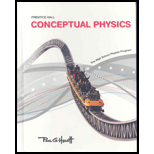
Concept explainers
Consider a pair of particles with equal charges. When released, they fly apart from each other. Your teacher asks how the speeds will compare when they are ten times farther apart than when first released. Jess says that since the force on the particles decreases with distance, their speeds will be less. Marie says no, the speed of the repelled particles increases as long as they interact with each other. With whom do you agree or disagree, and why?
To explain: Whether the argument of person J or M is correct.
Answer to Problem 44A
M is correct. Acceleration will decrease with the increasing time.
Explanation of Solution
Introduction:
When two like charges are placed together, then they repel each other as long as they experience their respective force.
When a pair of particles with equal charges is distributed, then due to no external force, electron-electron opposes each other. Even at the distance of ten times, if they experience the same repelling force due to long-gone electron, then it will keep moving apart. But, with the increasing distance, the force will be faded and the acceleration, but not speed, will decrease.
Conclusion:
As long as like charges experience their respective forces, it will keep moving apart even at the distance of ten times from the initial position of release. But, their acceleration, but not speed, will keep decreasing with the increasing distance. Thus, M’s argument is correct.
Chapter 32 Solutions
Conceptual Physics: The High School Physics Program
Additional Science Textbook Solutions
College Physics: A Strategic Approach (3rd Edition)
Physics for Scientists and Engineers: A Strategic Approach with Modern Physics (4th Edition)
Life in the Universe (4th Edition)
Cosmic Perspective Fundamentals
Conceptual Physical Science (6th Edition)
Essential University Physics (3rd Edition)
 College PhysicsPhysicsISBN:9781305952300Author:Raymond A. Serway, Chris VuillePublisher:Cengage Learning
College PhysicsPhysicsISBN:9781305952300Author:Raymond A. Serway, Chris VuillePublisher:Cengage Learning University Physics (14th Edition)PhysicsISBN:9780133969290Author:Hugh D. Young, Roger A. FreedmanPublisher:PEARSON
University Physics (14th Edition)PhysicsISBN:9780133969290Author:Hugh D. Young, Roger A. FreedmanPublisher:PEARSON Introduction To Quantum MechanicsPhysicsISBN:9781107189638Author:Griffiths, David J., Schroeter, Darrell F.Publisher:Cambridge University Press
Introduction To Quantum MechanicsPhysicsISBN:9781107189638Author:Griffiths, David J., Schroeter, Darrell F.Publisher:Cambridge University Press Physics for Scientists and EngineersPhysicsISBN:9781337553278Author:Raymond A. Serway, John W. JewettPublisher:Cengage Learning
Physics for Scientists and EngineersPhysicsISBN:9781337553278Author:Raymond A. Serway, John W. JewettPublisher:Cengage Learning Lecture- Tutorials for Introductory AstronomyPhysicsISBN:9780321820464Author:Edward E. Prather, Tim P. Slater, Jeff P. Adams, Gina BrissendenPublisher:Addison-Wesley
Lecture- Tutorials for Introductory AstronomyPhysicsISBN:9780321820464Author:Edward E. Prather, Tim P. Slater, Jeff P. Adams, Gina BrissendenPublisher:Addison-Wesley College Physics: A Strategic Approach (4th Editio...PhysicsISBN:9780134609034Author:Randall D. Knight (Professor Emeritus), Brian Jones, Stuart FieldPublisher:PEARSON
College Physics: A Strategic Approach (4th Editio...PhysicsISBN:9780134609034Author:Randall D. Knight (Professor Emeritus), Brian Jones, Stuart FieldPublisher:PEARSON





